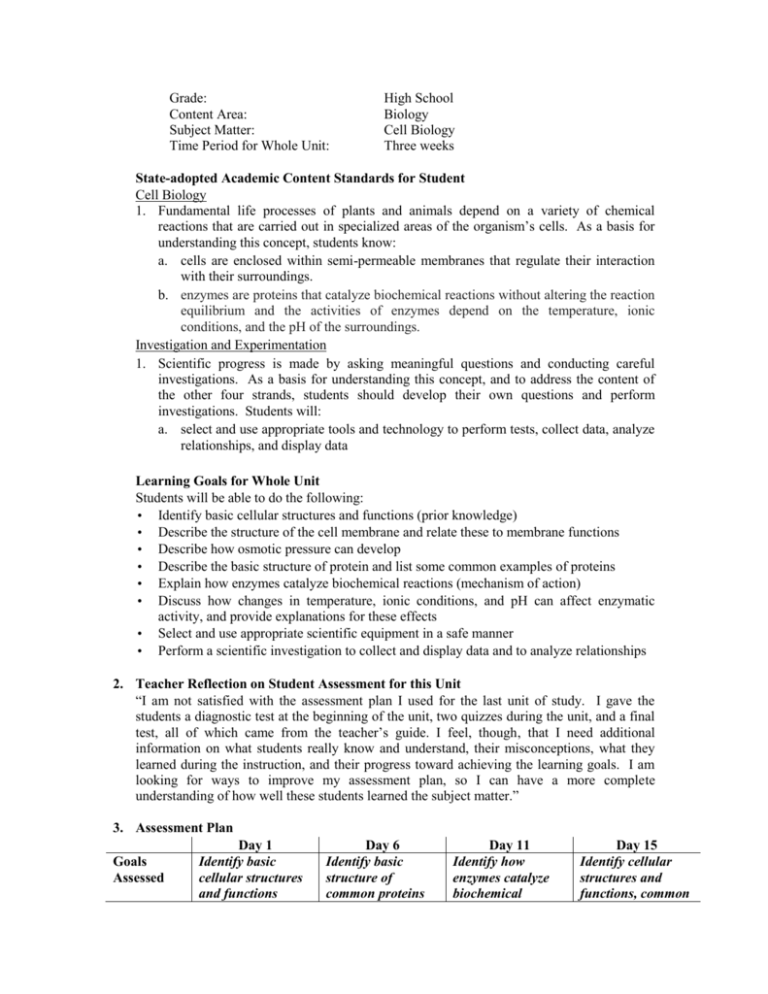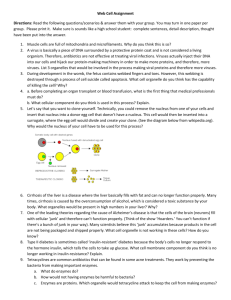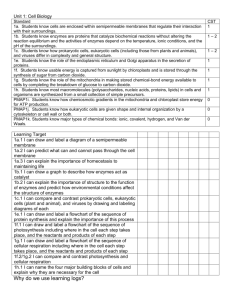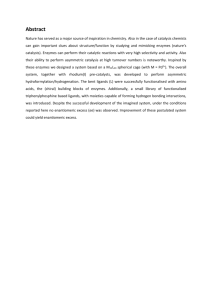File
advertisement

Grade: Content Area: Subject Matter: Time Period for Whole Unit: High School Biology Cell Biology Three weeks State-adopted Academic Content Standards for Student Cell Biology 1. Fundamental life processes of plants and animals depend on a variety of chemical reactions that are carried out in specialized areas of the organism’s cells. As a basis for understanding this concept, students know: a. cells are enclosed within semi-permeable membranes that regulate their interaction with their surroundings. b. enzymes are proteins that catalyze biochemical reactions without altering the reaction equilibrium and the activities of enzymes depend on the temperature, ionic conditions, and the pH of the surroundings. Investigation and Experimentation 1. Scientific progress is made by asking meaningful questions and conducting careful investigations. As a basis for understanding this concept, and to address the content of the other four strands, students should develop their own questions and perform investigations. Students will: a. select and use appropriate tools and technology to perform tests, collect data, analyze relationships, and display data Learning Goals for Whole Unit Students will be able to do the following: • Identify basic cellular structures and functions (prior knowledge) • Describe the structure of the cell membrane and relate these to membrane functions • Describe how osmotic pressure can develop • Describe the basic structure of protein and list some common examples of proteins • Explain how enzymes catalyze biochemical reactions (mechanism of action) • Discuss how changes in temperature, ionic conditions, and pH can affect enzymatic activity, and provide explanations for these effects • Select and use appropriate scientific equipment in a safe manner • Perform a scientific investigation to collect and display data and to analyze relationships 2. Teacher Reflection on Student Assessment for this Unit “I am not satisfied with the assessment plan I used for the last unit of study. I gave the students a diagnostic test at the beginning of the unit, two quizzes during the unit, and a final test, all of which came from the teacher’s guide. I feel, though, that I need additional information on what students really know and understand, their misconceptions, what they learned during the instruction, and their progress toward achieving the learning goals. I am looking for ways to improve my assessment plan, so I can have a more complete understanding of how well these students learned the subject matter.” 3. Assessment Plan Goals Assessed Day 1 Identify basic cellular structures and functions Day 6 Identify basic structure of common proteins Day 11 Identify how enzymes catalyze biochemical Day 15 Identify cellular structures and functions, common and the mechanism of osmosis Type Formal, diagnostic test from curriculum guide; multiple choice; formative Formal quiz from the textbook; multiple choice; formative reactions, appropriate scientific equipment, and safety measures Formal quiz from the textbook; multiple choice; formative Purpose Assess previous knowledge and skills Assess acquired concepts and skills Assess acquired skills and concepts Implementation Individual Individual Individual assessment; paper assessment; paper assessment; paper and pencil; teacher and pencil; teacher and pencil; teacher corrects with an corrects with an corrects with an answer key answer key answer key Tell students of Inform students of Inform students of scores and inform correct and correct and student of correct incorrect items incorrect items and incorrect items To determine what To determine who To determine who needs to be has learned the has learned the reviewed and material presented material presented where to begin teaching _____________________________________________ Feedback Strategies Informing Instruction proteins, osmosis, enzyme catalysis, scientific equipment and safety measures Formal, final chapter/unit exam from textbook; multiple choice and fill in the blank; summative Assess acquired knowledge and skills from instructional unit Individual assessment; paper and pencil; teacher corrects with an answer key Inform students of correct and incorrect items To determine the level of each student’s achievement toward the goals B. Questions for Case Study 2 1.a. 1.b. Identify one strength in the assessment plan and explain why it is a strength in relation to the learning goals of this unit. Identify one weakness in the assessment plan and explain why it is a weakness in relation to the learning goals of this unit. One strength of the assessment plan is that by using formal tests and quizzes, the teacher is able to assess student understanding of the subject matter in a unified, standardized method. That is, the teacher is able to make comparisons of all the students and determine what material students all understood, what material only some students understood (and therefore needs to be reviewed) and what material was not covered successfully (i.e. if all students were unable to answer the questions). The assessment material is clearly defined for the students and students know what is expected of them and the goals of the unit. The unified assessment method is a strength because the teacher can clearly identify what topics (learning goals) students understood and what topics students had trouble understanding. Because it ensures all students are assessed using the same method, expectations are the same and is a fair assessment method to address student comprehension of the learning goals. This method ensures that all students will be able to recall certain facts as they relate to the learning goals. Using multiple choice and fill in the blank encourages students to understand certain facts as they relate to basic cellular structures, functions, etc The weakness of the assessment plan is that is does not provide real-world application of the learning goals and does not encourage critical thinking and problem solving. Testing does not encourage students to think critically and relate concepts or learning goals to the real world. Students are only studying to pass the test and are not learning how to relate the concepts to life outside of the classroom. For example, two of the learning goals are “Select and use appropriate scientific equipment in a safe manner” and “Perform a scientific investigation to collect and display data and to analyze relationships”. A much more accurate way to assess student comprehension of these learning goals would be to have students perform a lab where they must design an experiment, perform an investigation, and relate it back to the concepts of osmosis, catalysts, enzymes, proteins, etc. It would have provided a real-world application where students would have to apply concepts learned and problem solve. It would have assessed deeper student understanding of the learning goals. It would have also been a way for students who may not be the best test takers to demonstrate their knowledge and understanding of the learning goals through their performance. 2. Suppose you found the following additional assessment in a supplementary resource. Think about how the additional assessment could improve the teacher’s assessment plan. Additional Assessment Students will conduct an experiment on enzymatic activity, submit a lab report of their experiment, and address the following questions in their analysis: 1. Compare and contrast the effects of temperature, ionic conditions, and pH on enzymatic activity based on the results of the scientific investigation you performed in the lab. 2. Use your investigational results to justify your findings. Explain to the teacher how it might be used to improve the plan by answering the following questions: 2.a. When in the plan would you use this assessment? 2.b. What goals would be assessed by this assessment? I would use this assessment on day 9, before the quiz on enzyme function and safety methods. It would provide an opportunity for students to understand a real-world application of the learning goals and reinforce concepts taught in class. Therefore, by the time the students took the quiz, they would understand the importance of the concepts outside of class and be able to relate their experiences in the lab to the questions on the quiz. By encouraging higher level thinking, students will be challenged and encouraged to apply concepts. • Describe the basic structure of protein and list some common examples of proteins : as enzymes are amino acid chains, it would build on prior knowledge of what a protein is and • • • • one of the roles it plays in living things. Explain how enzymes catalyze biochemical reactions (mechanism of action): it would provide a real-world application of how enzymes work as catalysts in a chemical reaction. Students would have to critically think about the role of enzymes and how different environmental factors affect their role. This lab would also encourage problem solving as students analyze how an enzyme affects a reaction. Discuss how changes in temperature, ionic conditions, and pH can affect enzymatic activity, and provide explanations for these effects: During the lab and also in the post-lab questions, students must observe and then analyze the role of temperature, ionic conditions, and pH in a chemical reaction using an enzyme. Select and use appropriate scientific equipment in a safe manner: because this is a performance assessment in a lab, students must understand how is appropriate lab etiquette. It assesses students on if they know how to follow the rules of a lab. Perform a scientific investigation to collect and display data and to analyze relationshipsthis lab encourages critical thinking and problem solving. Students must perform and apply the concepts learned in lab to a realworld application. 2.c. What type of assessment would it be? This is a performance assessment that could be seen as both criterion-referenced and interim/benchmark. The test at the end of the unit would be summative. This lab, in contrast, would measure student performance against learning goals and standards and be interim as it does evaluate student performance and knowledge of material, but can be used to predict how students will do on the end of unit test. 2.d. What would be the purpose of the assessment? The purpose of the assessment is to determine students understanding of the concepts as they relate to lab procedures and enzymatic activity. It encourages higher level thinking and comprehension. It provides a benchmark for student understanding of the concepts taught in class and provides application of the concepts that can then be tested on the final unit test. In addition, the assessment evaluates how students can apply the concepts and critically think about their application. It also differentiates the types of assessment methods used in the unit. Some students may perform better in a performance based assessment than on a test or quiz. 2.e. How would you implement the assessment? In order to implement this assessment, students would need to have foundational understanding of the concepts being assessed and an understanding of how to perform experiments and analyze results. Therefore prior to the lesson, the teacher needs to address the standards being assessed and also provide the students activities that encourage higher level thinking. This could be done through student’s reading an experiment associated with proteins and having students answer question that apply the data and results of the experiment to larger concepts. By encouraging problem solving and critical thinking skills prior to the lab, students will be in the right frame of mind to perform a lab where they must think critically and problem solve. In addition, collaborative learning will greatly benefit the students. Having the students conduct the lab with a partner, will make the content more accessible to all students and allow students to problem solve together. Before conducting the lab, the teacher should go over the background information and problem with the students, to make sure everyone is clear on what the purpose of the lab is, and should encourage students to design labs that address the relationship of enzymes with pH, temperature, and ionic conditions. For example, the teacher could implement a lab where students are responsible for finding a solution to keep an apple from turning brown. The teacher could explain the materials available for students to use (fridge, hot plate, acetic acid, lemon juice, salt, milk of magnesium) and then ask students to design a lab using these materials. Students will then have to apply their understanding of enzymatic activity and the conditions that affect it. Students can then answer post lab questions that relate what they saw in the lab to the concepts the teacher presents. 2.f. What feedback strategies would you use? By having students turn in a lab report, complete with post lab questions, the teacher is able to provide commentary on their lab methodology and understanding of the subject. The teacher can also circulate around the classroom as students are performing the lab to informally assess student comprehension of the material. She can engage with students as she circulates to ask why they are using specific methodology, what the experiment is showing them, and to gauge student understanding of the concepts. 2.g. How would the results of the assessment inform instruction? The results of this assessment would inform instruction by demonstrating how well students understand the concepts taught in class and can apply them to a scientific experiment. It would demonstrate not only student understanding of the standards, but also show how well students can engage with the material and use higher level thinking to apply it to real-world problems. It could also demonstrate student misconceptions of the subject matter through analysis of their experimental method and the procedure they use to determine enzymatic activity. The instructor can then determine what concepts she needs to cover more in-depth and what concepts students understand, especially before the final quiz and test. In addition, by encouraging collaborative learning, the teacher can assess how beneficial socialization and communication is for student understanding of complex science concepts, and use these teaching methods more in her unit plan. 3. Explain how using the additional assessment as you described in question 2 improves the teacher’s assessment plan and what specific information would be gained about what the students really know and understand about the content area, their misconceptions, and their progress toward achieving the learning goals. Using a performance based assessment, in the form of a lab on enzymatic activity, improves the teacher’s assessment plan because it encourages higher level thinking and differentiates the instruction. Because the rest of the assessment plan is based on standardized tests, there is no room for critical thinking and student demonstration of application of the concepts. Therefore, by using the lab, students are encouraged to problem solve and think about how the concepts taught in the unit relate to life outside the classroom. By using the lab, the teacher can assess student understanding of applying and implementing concepts in a real-world problem. Hands-on, performance based, learning also allows students to gain a more comprehensive understanding because they can relate it to more than just facts. In addition, as the teacher circulates during the lab, she is able to see what students do not understand based on their errors in their experimental design. However, she can also witness their progress towards achieving the learning goals as they learn how to safely set up and perform a lab and use trial and error to explain the post lab questions. This assessment encourages students to relate the concepts to each other and build on prior knowledge (including their understanding of the scientific method) to formulate a complete understanding of how enzymes learn. It provides the opportunity for formal and informal assessment as she can formally grade the students’ lab reports and can also informally assess their comprehension of the subject (by circulating and engaging with students) while they conduct the lab.







